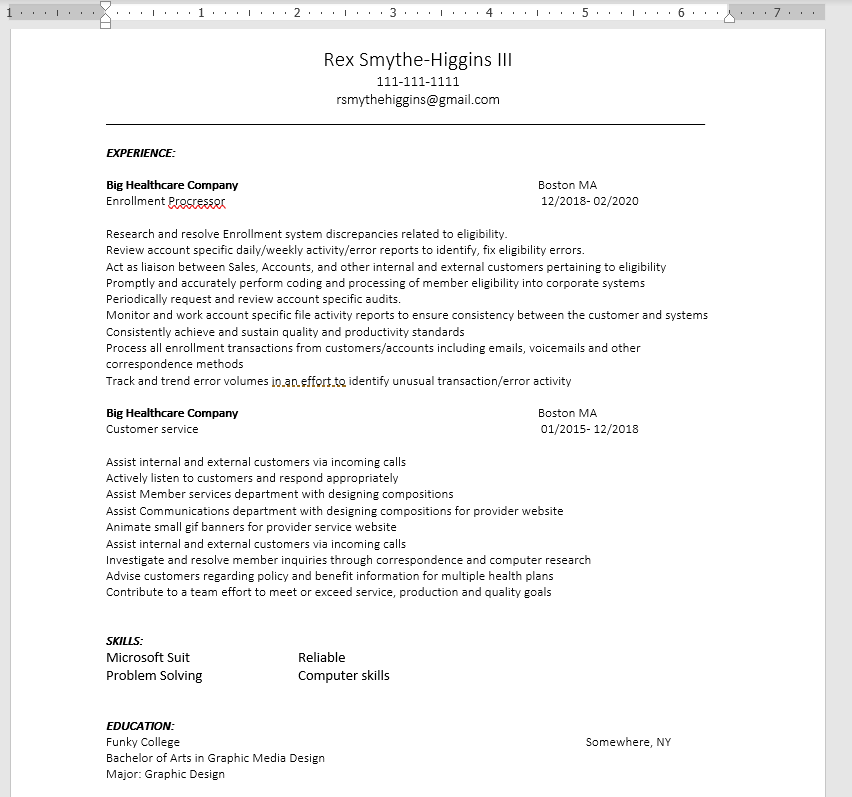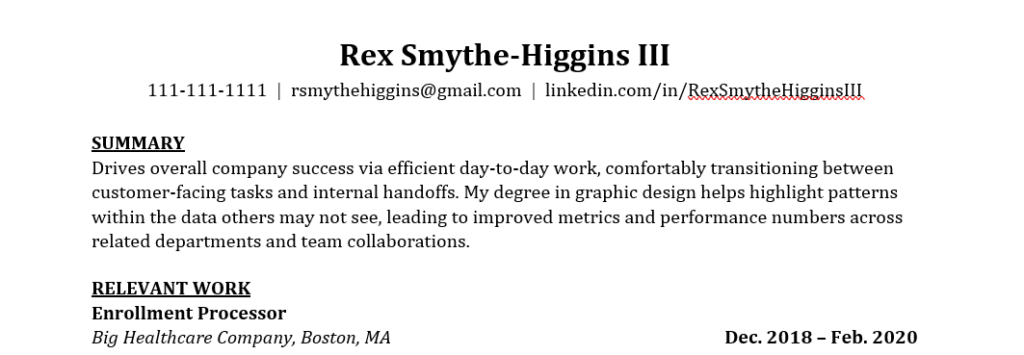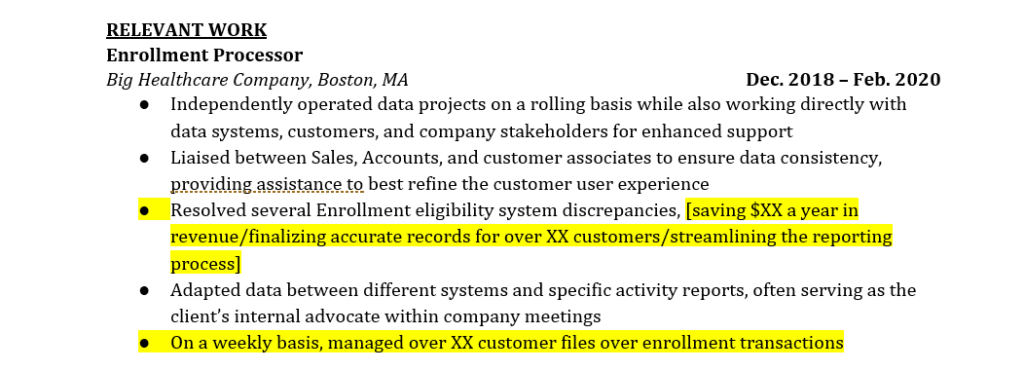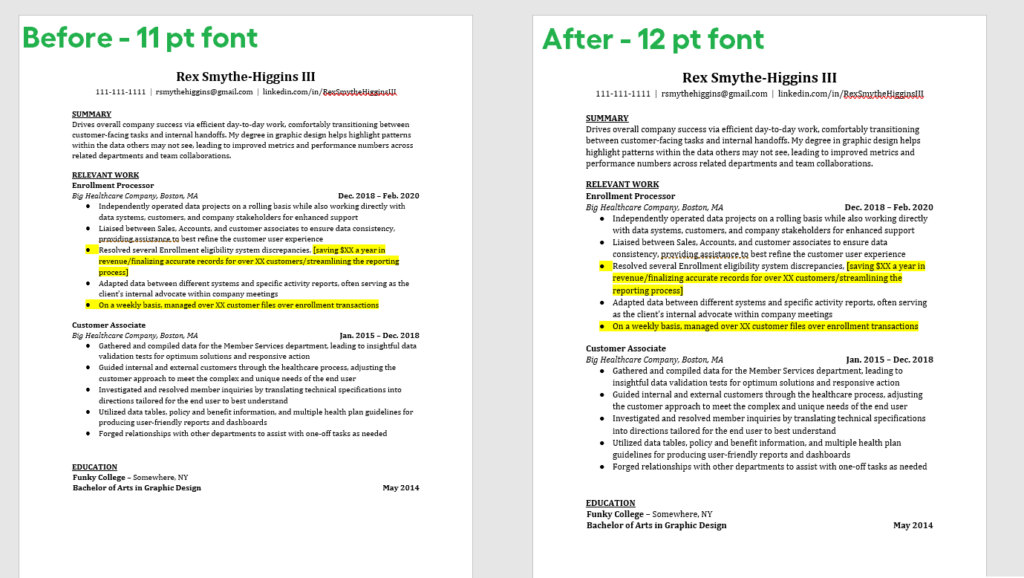Resume Case Study: My Role Got Nuked in 2020
I am BACK with another 2020 resume case study! This time I’m helping out “Rex,” who I got to meet via this blog! He’s a family man who was laid off in February when coronavirus began descending in full force. It’s been a struggle since then to grab work, and he’s asked me for DOUBLE help by reworking his resume AND LinkedIn. Let’s GOOOOOOOO!
About “Rex”
Funny enough, Rex, like me, also lives in New England and has worked in the Boston area for several years. He graduated from college in 2014 and began working for a healthcare company in 2015, getting a nice promotion along the way. He also bought a house in the ‘burbs and had a lovely little kid.
And then 2020 showed up and WRECKED HIS SHIT. Despite spending half a decade at this place and getting mightily attached, he got the boot once layoffs came. In the months since he’s been toiling away at getting a new job to no avail.
Which initially surprised me at first, because Rex has some very transferrable skills in account management and data entry. Like marketing and accounting, those are crucial to any business. There was some disconnect going on here, and it had to be down to something in his resume and profile.
The Pros:
He has some great skills that, again, are vital to running any company. His long tenure may have worked against him in salary raises, but it’ll help him immensely in the job search! Rex also has relatively modest salary requirements for the Boston area (the minimum being low 40s) which seriously expands the opportunities he has.
The Cons:
When we were messaging back and forth, Rex revealed he’s very unsure of what jobs he actually wants, feeling clueless. Without figuring out what jobs you want to aim for, you can’t get recruiters interested in you. They want to find candidates that are tailor-made, not a one-size-fits-all. As a result we worked on finding roles Rex could aim for, settling on Account Manager, Business Analyst, and Data Analyst.
A potential con is also the disconnect between Rex’s degree and his line of work. It shouldn’t matter that much since he’s been out of school for so long, but we don’t have much on his resume either; that means his degree stands out more than usual, which could be a deterrent.
But there’s more issues here.
Here’s Rex’s resume layout:

Rex doesn’t have the same problems as Olga did from my last study. His formatting fits very neatly within the margins, AND it’s all down to one page! Go Rex! However, there are some very glaring red flags in this resume case study. The worst offender is the spelling issues, which includes HIS JOB TITLE. Something that would take him two seconds to fix sent this 2020 resume straight to the trash; it’s also so pervasive on resumes because people get so sick of looking at it they don’t check for errors.
The other big mistake was one spellcheck didn’t pick up: under the Skills section, “Microsoft Suite” is missing an E. Which is, to put it mildly, pretty bad. Rex is in the data entry business, not some weird branch of corporate fashion.

The formatting is all over the place too. The more recent job title is capitalized but “Customer service” doesn’t follow. Also, “Customer service” is an incomplete job title.
The bullet points are missing actual bullets.
Some points end with a period, others do not.
There’s a glaring amount of empty space, exacerbated by the long separator at the top of the page.
And I’m being extra nit-picky about this part: the font makes me sad so it therefore has to go.
New Formatting
The VERY FIRST fix I did was making those two spelling changes; the worst offenders do not get the luxury of neglect. Now we’re ready to move on to the not-as-bad stuff, including changing the formatting to tighten up the negative space.
We’re going to remove that line up top and make the font something that’s less drab and more sophisticated; Times New Roman is the default, but something like Cambria is also nice so we’ll use that. (Fun fact, my font of choice for my own resume is Book Antiqua. That is one sexy, sophisticated font. Highly recommend.)

For my next trick I’m going to borrow the previous resume case study formatting since it worked so well for her. We’re going to bold Rex’s name at the top and organize his contact information onto one line, which includes adding his LinkedIn profile link. You want to give recruiters as many ways to contact you as possible, after all.
That formatting extends to every other section as well. Time to better organize the work titles and ADD THOSE BULLET POINTS.

That’s looking more polished already!
The Summary Section
I didn’t include this in my last case study, but having a summary is a helpful part of a great resume. Mine has one, as does Olga’s. Rex needs one too, for three very important reasons.
- One, he needs to fill out more space on his resume. A summary section will help him do that.
- Two, this gives Rex control over capturing a recruiter’s attention. A summary is the only place on the resume you can show your human side and hints about your personality. That glimpse into who he is could be the hook that gets that recruiter thinking about him more, which in turn leads to the hiring process. You’re in!
- And three, this is the perfect chance to mitigate any downside his art degree might impose.
Let’s talk further about that. So his education was in arts but his career is not. It happens. We’re going to explain that quickly in his summary and spin it into a positive, because it IS a positive. I’m speaking as a former art kid who was the only student in my class to take the AP Art exam without actually making it into the class. (And then getting a higher score than some of them in there, but that’s a brag for another day.)
Art helps you see and understand the world in a different light; art also encourages you to develop a growth mindset, and helps along the idea that you don’t have to be sharp and perfect to contribute something great to the world. Most importantly for data entry, an art background helps you see patterns in the numbers in front of you that may go unchecked by others.
That improves your ability to assist customers and work collaboratively with other departments.
Which is what Rex has done.
Knowing all of this, I looked at the wording from job postings (including remote ones) that Rex liked the most. I then took that verbiage and applied it the best I could. Of course Rex will still have to write this in his own words, but this is what I came up with:

Hell to the yes.
Resume summary sections should be three lines minimum and discuss what you bring to the table. For reference, here’s Olga’s resume summary:
Experienced bilingual professional specializing in program efficiency and measured results. Ability to manage several projects at once under strict deadlines and hard requirements. Works well individually and collaboratively, with a focus on building and maintaining excellent relationships for streamlined success.
I almost forgot a fourth reason to do this: it lets you shoehorn in some more keywords, which is necessary for those evil HR algorithms out there.
The Relevant Work Section
This needs work.
To start, make everything in the correct past tense! If someone was describing an event from five years ago using present tense I’d be confused as hell; on resumes you need to write your CURRENT job duties in the present tense and your PAST job duties in the past tense. Like you would in real life.
Now we really need to tackle some of these bullet points. “Consistently achieve standards” is what an unimaginative third grade teacher will write about the most boring student she’s ever had. Rex needs to give himself more credit than that so we’re axing that.
You do NOT want to describe your job in the most boring way possible.
You want to show your duties, yes, but you also want to show off your achievements. How did you help the people you worked with? The company? Give me actionable, specific stuff to show yourself off.
Those are questions we need Rex to answer. How many accounts did he work with on a daily/weekly/monthly basis? We’ll pick the most impressive number and go from there.
Finally, we’re going to take a couple of job listings Rex liked and incorporate that wording into his resume. A job requesting an “independent operator” inspired describing one of Rex’s duties as his having “independently operated” a crucial task. Another was laser-focused on UX (user experience) which brought about adding that Rex’s role helped “refine the customer user experience”. His most recent job section now reads as follows:

The highlights are for Rex; on his end he’ll update the X’s with the correct numbers. Those get the highlighter so he won’t mistakenly send out that resume beforehand.
The Skills Section
Oh, this part needs to go. No shade to Rex, but there are only four skills here and they are the most generic skills ever. Anyone halfway capable can claim all four “skills,” and Rex deserves better than to seem less than fully capable. Time to go, skills section. You will not be missed.
The Education Section
Whew, this part needs very little work. Just correcting the formatting and removing the redundant major line. Hiring folks already know what Rex’s major was because that’s the degree he got; repeating himself harms, not helps.
Tidying Up
It looks great now, with Rex’s relevant data entry experience optimized in all its glory. Now the only issue to deal with is the empty space we still have; there’s five lines of nothing at the tail end of the page we need to deal with. Luckily, everything so far (besides his name) is in size 11 font, making it an easy choice to bump it up to an equally acceptable size 12 font. Here’s the before and after:

Ta da, Rex’s resume is now prime for the job search! Once he adds the numbers on his end there’s one last step he needs to take.
That is having someone trustworthy look over his resume and offer feedback.
I’ve luckily worked with several account managers and data analysts in my career, which helped enormously in knowing what, if any, industry hiring quirks there may be. With that said, anyone getting their resume rewritten should get a second opinion, no matter how prestigious the entity that did it. Case in point: Bitches Get Riches averted disaster after a family member PAID someone else to rewrite hers.
Let me repeat: that agency WAS GIVEN REAL MONEY to commit fraud by proxy. Uncovering that lie during the hiring process would have nuked that poor girl’s chances immediately. Uncovering it after she was hired could spell losing all career credibility and legal trouble on top of that. With the staffing agency likely getting off scot-free. I hope she got her money back; this is why I still push for some fresh eyes on the rez to check things out. This is your financial means we’re talking about here; protect it as much as you can.
And that wraps up the latest 2020 resume case study! What should I make sure to include when going over Rex’s LinkedIn profile?
Cover image credit: Daniela Levis Pelusi via Unsplash


The formatting alone is a massive improvement. Love this idea of helping people with resumes. Such an important factor for those looking to change jobs or increase income.
It really is – your resume is your marketing campaign on why you should get hired. Impress the right person and you’re golden.